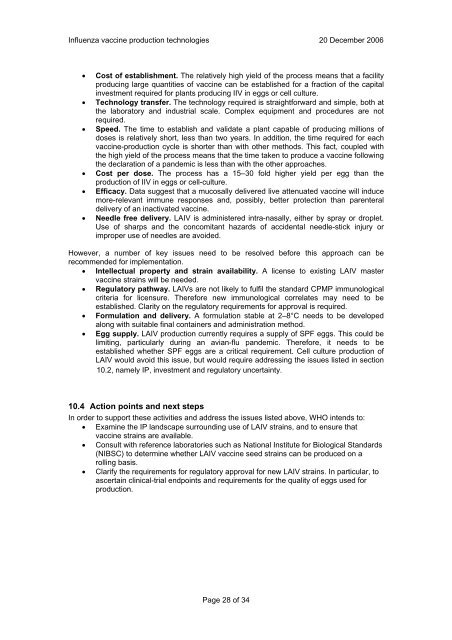A review of production technologies for ... - World Health Organization
A review of production technologies for ... - World Health Organization
A review of production technologies for ... - World Health Organization
Create successful ePaper yourself
Turn your PDF publications into a flip-book with our unique Google optimized e-Paper software.
Influenza vaccine <strong>production</strong> <strong>technologies</strong> 20 December 2006<br />
• Cost <strong>of</strong> establishment. The relatively high yield <strong>of</strong> the process means that a facility<br />
producing large quantities <strong>of</strong> vaccine can be established <strong>for</strong> a fraction <strong>of</strong> the capital<br />
investment required <strong>for</strong> plants producing IIV in eggs or cell culture.<br />
• Technology transfer. The technology required is straight<strong>for</strong>ward and simple, both at<br />
the laboratory and industrial scale. Complex equipment and procedures are not<br />
required.<br />
• Speed. The time to establish and validate a plant capable <strong>of</strong> producing millions <strong>of</strong><br />
doses is relatively short, less than two years. In addition, the time required <strong>for</strong> each<br />
vaccine-<strong>production</strong> cycle is shorter than with other methods. This fact, coupled with<br />
the high yield <strong>of</strong> the process means that the time taken to produce a vaccine following<br />
the declaration <strong>of</strong> a pandemic is less than with the other approaches.<br />
• Cost per dose. The process has a 15–30 fold higher yield per egg than the<br />
<strong>production</strong> <strong>of</strong> IIV in eggs or cell-culture.<br />
• Efficacy. Data suggest that a mucosally delivered live attenuated vaccine will induce<br />
more-relevant immune responses and, possibly, better protection than parenteral<br />
delivery <strong>of</strong> an inactivated vaccine.<br />
• Needle free delivery. LAIV is administered intra-nasally, either by spray or droplet.<br />
Use <strong>of</strong> sharps and the concomitant hazards <strong>of</strong> accidental needle-stick injury or<br />
improper use <strong>of</strong> needles are avoided.<br />
However, a number <strong>of</strong> key issues need to be resolved be<strong>for</strong>e this approach can be<br />
recommended <strong>for</strong> implementation.<br />
• Intellectual property and strain availability. A license to existing LAIV master<br />
vaccine strains will be needed.<br />
• Regulatory pathway. LAIVs are not likely to fulfil the standard CPMP immunological<br />
criteria <strong>for</strong> licensure. There<strong>for</strong>e new immunological correlates may need to be<br />
established. Clarity on the regulatory requirements <strong>for</strong> approval is required.<br />
• Formulation and delivery. A <strong>for</strong>mulation stable at 2–8°C needs to be developed<br />
along with suitable final containers and administration method.<br />
• Egg supply. LAIV <strong>production</strong> currently requires a supply <strong>of</strong> SPF eggs. This could be<br />
limiting, particularly during an avian-flu pandemic. There<strong>for</strong>e, it needs to be<br />
established whether SPF eggs are a critical requirement. Cell culture <strong>production</strong> <strong>of</strong><br />
LAIV would avoid this issue, but would require addressing the issues listed in section<br />
10.2, namely IP, investment and regulatory uncertainty.<br />
10.4 Action points and next steps<br />
In order to support these activities and address the issues listed above, WHO intends to:<br />
• Examine the IP landscape surrounding use <strong>of</strong> LAIV strains, and to ensure that<br />
vaccine strains are available.<br />
• Consult with reference laboratories such as National Institute <strong>for</strong> Biological Standards<br />
(NIBSC) to determine whether LAIV vaccine seed strains can be produced on a<br />
rolling basis.<br />
• Clarify the requirements <strong>for</strong> regulatory approval <strong>for</strong> new LAIV strains. In particular, to<br />
ascertain clinical-trial endpoints and requirements <strong>for</strong> the quality <strong>of</strong> eggs used <strong>for</strong><br />
<strong>production</strong>.<br />
Page 28 <strong>of</strong> 34

















